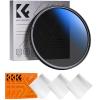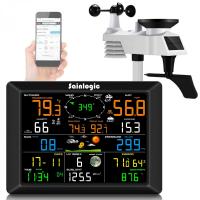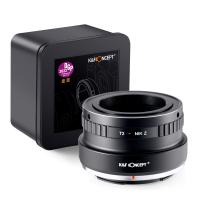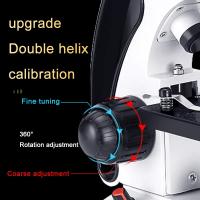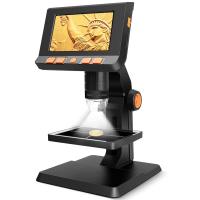Who Invented The Microscope In The Renaissance?
The invention of the microscope in the Renaissance is often attributed to Zacharias Janssen, a Dutch spectacle-maker, and his father Hans Janssen. They are believed to have created the first compound microscope around the late 16th century. However, there is some debate and uncertainty surrounding the exact origins of the microscope, as other individuals such as Hans Lippershey and Hans and Zacharias' rival, Hans Drebbel, have also been associated with its invention.
1、 Early Microscope Development

The invention of the microscope in the Renaissance is often attributed to several individuals, including Zacharias Janssen, Hans Lippershey, and Hans and Zacharias Janssen. However, the exact origin of the microscope is still a matter of debate among historians and scholars.
Recent research suggests that the true inventor of the microscope may have been a combination of these individuals, as well as others who were experimenting with lenses and magnification during the Renaissance period. It is believed that these early microscopes were simple, single-lens devices that were used to examine small objects such as insects, plant cells, and other tiny specimens.
The latest point of view on the development of the microscope in the Renaissance emphasizes the collaborative and iterative nature of scientific discovery during this time. Rather than attributing the invention to a single individual, historians now recognize the contributions of multiple inventors and experimenters who were working in parallel to develop the technology.
This new perspective highlights the importance of shared knowledge and the exchange of ideas in the history of science. It also underscores the role of trial and error, as well as the incremental improvements made by different individuals, in the development of groundbreaking scientific instruments like the microscope.
2、 Renaissance Inventors and Innovations

The microscope is often attributed to being invented in the Renaissance, and the credit for its invention is commonly given to two Dutch spectacle makers, Hans Lippershey and Zacharias Janssen. They are believed to have created the first compound microscope around the turn of the 17th century. However, there is some debate among historians about the exact origins of the microscope, and some argue that the invention may have been a collaborative effort involving multiple individuals across different regions.
Recent research and scholarship have shed light on the contributions of other Renaissance inventors to the development of early microscopes. For example, the work of Italian polymath Galileo Galilei in the early 17th century also played a significant role in advancing the technology of lenses and optics, which were crucial for the improvement of microscopes.
Furthermore, the Renaissance was a period of great intellectual and scientific advancement, and it is likely that there were other lesser-known inventors and innovators who made important contributions to the development of early microscopes. As our understanding of history continues to evolve, it is important to consider the diverse perspectives and contributions of individuals from different backgrounds in the advancement of scientific knowledge during the Renaissance.
3、 Impact on Scientific Discoveries

The microscope was invented in the Renaissance by Zacharias Janssen, a Dutch spectacle maker, and his father Hans in the late 16th century. Their invention allowed for the observation of objects at a much smaller scale than was previously possible, revolutionizing the study of biology, medicine, and materials science.
The impact of the microscope on scientific discoveries has been profound. It enabled scientists to observe and study microorganisms, cells, and other tiny structures, leading to significant advancements in our understanding of biology and medicine. For example, the discovery of bacteria and other microorganisms paved the way for the development of germ theory and the understanding of infectious diseases.
Furthermore, the microscope has played a crucial role in the fields of materials science and nanotechnology, allowing scientists to study and manipulate materials at the nanoscale. This has led to the development of new materials with unique properties and applications.
In recent years, advancements in microscopy technology, such as the development of super-resolution microscopy, have further expanded our ability to observe and manipulate matter at the nanoscale. This has opened up new avenues for scientific research and technological innovation, with potential applications in fields such as medicine, electronics, and materials science.
Overall, the invention of the microscope in the Renaissance has had a lasting impact on scientific discoveries, shaping our understanding of the natural world and driving advancements in various scientific disciplines.
4、 Microscope Evolution and Improvements

The microscope was invented in the Renaissance by multiple individuals, but the most notable figure associated with its invention is the Dutch spectacle maker Zacharias Janssen. Janssen is often credited with creating the first compound microscope around 1590, which consisted of a tube with a lens at each end. However, there is some debate about the true inventor of the microscope, as Hans Lippershey and Hans Janssen, father of Zacharias Janssen, are also mentioned in historical accounts.
Since its invention, the microscope has undergone significant evolution and improvements. In the 17th century, Robert Hooke used a compound microscope to observe and describe the structure of cork, coining the term "cell" for the first time. Later, in the 19th century, advancements in lens manufacturing and the development of the achromatic lens significantly improved the quality and clarity of microscope images.
In the modern era, the invention of electron microscopes has revolutionized the field of microscopy, allowing scientists to observe structures at the nanoscale. Additionally, the integration of digital imaging technology has further enhanced the capabilities of microscopes, enabling researchers to capture, analyze, and share high-resolution images with unprecedented detail.
Overall, the invention of the microscope in the Renaissance laid the foundation for centuries of scientific discovery and continues to be a vital tool in various fields, including biology, medicine, materials science, and nanotechnology.

